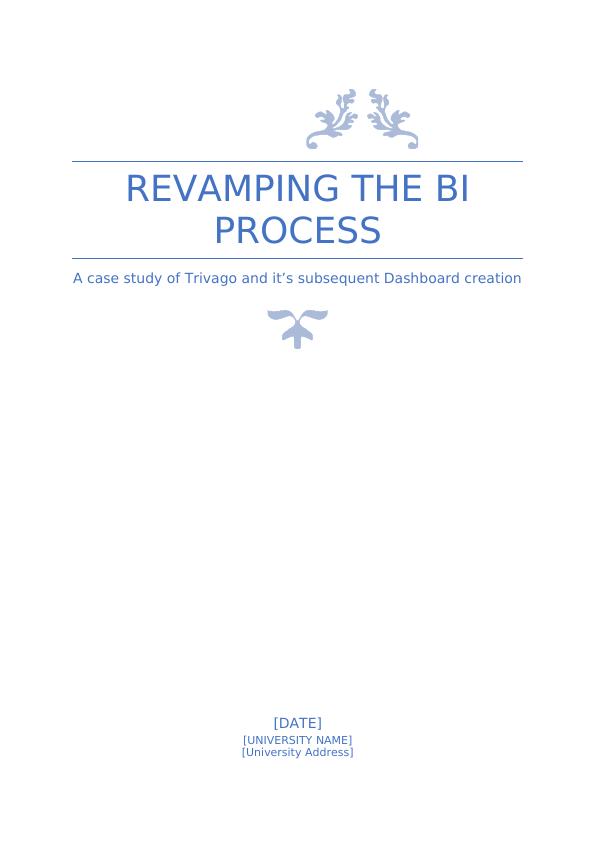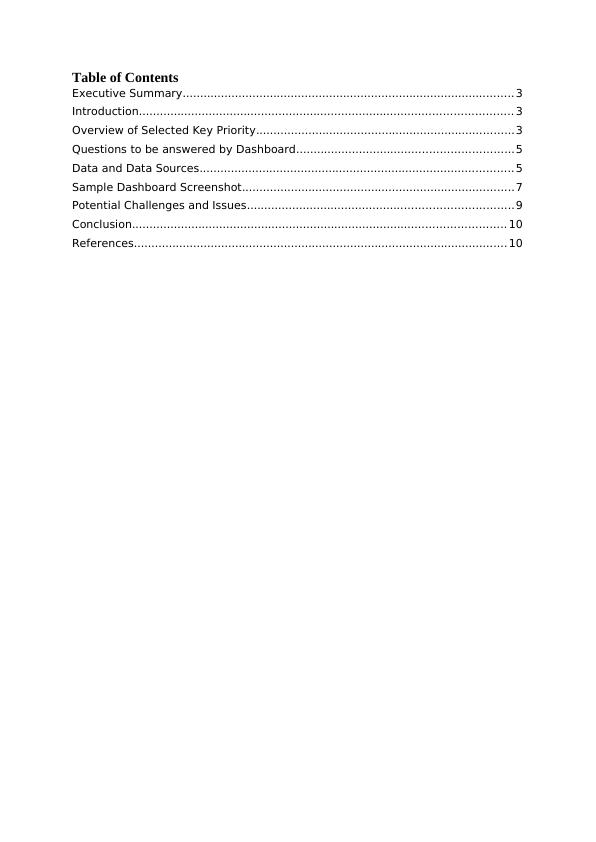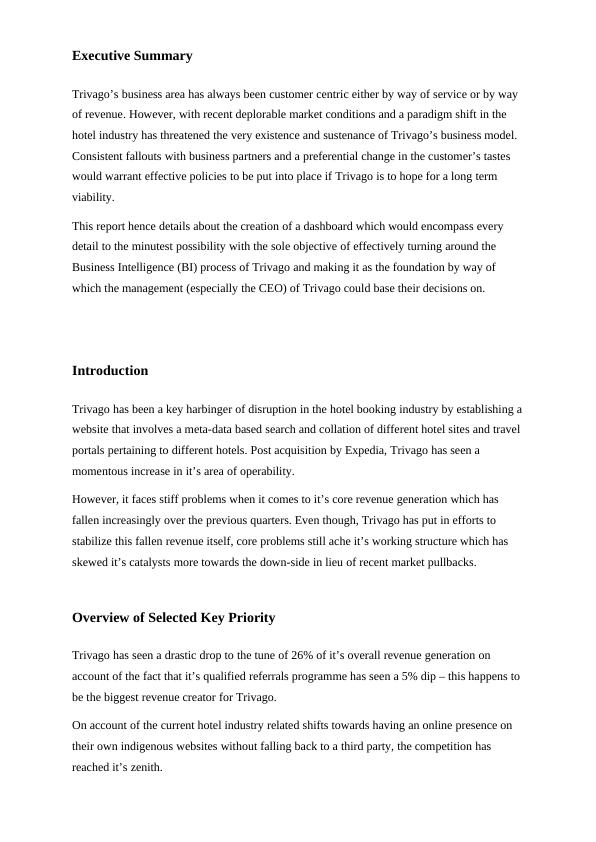Revamping the BI Process: A Case Study of Trivago and its Dashboard Creation
Added on 2022-12-08
11 Pages2764 Words397 Views
UNIVERSITY OF SOUTH AUSTRALIA
Assignment Cover Sheet – Internal
Please note: All text based assessment tasks should be submitted electronically using learnonline Gradebook. A cover
sheet is automatically created and includes your name and student ID therefore you should not upload or embed the
document in your assignment.
If submitting your assignment in hard copy you should complete and attached this Assignment Cover Sheet. Please check
your Course Outline or contact your School Office for assignment submission locations.
Name:
Mail ID
Email: @mymail.unisa.edu.au
Course code and title:
School: Program Code:
Course Coordinator: Tutor:
Day, Time, Location of Tutorial/Practical:
Assignment number: Due date:
Assignment topic as stated in Course Outline:
Further Information: (e.g. state if extension was granted and attach evidence of approval, Revised Submission Date)
I declare that the work contained in this assignment is my own, except where acknowledgement of sources is made.
I authorise the University to test any work submitted by me, using text comparison software, for instances of plagiarism. I
understand this will involve the University or its contractor copying my work and storing it on a database to be used in future to
test work submitted by others.
I understand that I can obtain further information on this matter at https://lo.unisa.edu.au/course/view.php?id=3839
Note: The attachment of this statement on any electronically submitted assignments will be deemed to have the same authority
as a signed statement.
Signed: Date:
Date received from student Assessment/grade Assessed by:
Recorded: Dispatched (if applicable):
Assignment Cover Sheet – Internal
Please note: All text based assessment tasks should be submitted electronically using learnonline Gradebook. A cover
sheet is automatically created and includes your name and student ID therefore you should not upload or embed the
document in your assignment.
If submitting your assignment in hard copy you should complete and attached this Assignment Cover Sheet. Please check
your Course Outline or contact your School Office for assignment submission locations.
Name:
Mail ID
Email: @mymail.unisa.edu.au
Course code and title:
School: Program Code:
Course Coordinator: Tutor:
Day, Time, Location of Tutorial/Practical:
Assignment number: Due date:
Assignment topic as stated in Course Outline:
Further Information: (e.g. state if extension was granted and attach evidence of approval, Revised Submission Date)
I declare that the work contained in this assignment is my own, except where acknowledgement of sources is made.
I authorise the University to test any work submitted by me, using text comparison software, for instances of plagiarism. I
understand this will involve the University or its contractor copying my work and storing it on a database to be used in future to
test work submitted by others.
I understand that I can obtain further information on this matter at https://lo.unisa.edu.au/course/view.php?id=3839
Note: The attachment of this statement on any electronically submitted assignments will be deemed to have the same authority
as a signed statement.
Signed: Date:
Date received from student Assessment/grade Assessed by:
Recorded: Dispatched (if applicable):

REVAMPING THE BI
PROCESS
A case study of Trivago and it’s subsequent Dashboard creation
[DATE]
[UNIVERSITY NAME]
[University Address]
PROCESS
A case study of Trivago and it’s subsequent Dashboard creation
[DATE]
[UNIVERSITY NAME]
[University Address]

Table of Contents
Executive Summary............................................................................................... 3
Introduction........................................................................................................... 3
Overview of Selected Key Priority..........................................................................3
Questions to be answered by Dashboard..............................................................5
Data and Data Sources.......................................................................................... 5
Sample Dashboard Screenshot..............................................................................7
Potential Challenges and Issues............................................................................9
Conclusion........................................................................................................... 10
References........................................................................................................... 10
Executive Summary............................................................................................... 3
Introduction........................................................................................................... 3
Overview of Selected Key Priority..........................................................................3
Questions to be answered by Dashboard..............................................................5
Data and Data Sources.......................................................................................... 5
Sample Dashboard Screenshot..............................................................................7
Potential Challenges and Issues............................................................................9
Conclusion........................................................................................................... 10
References........................................................................................................... 10

Executive Summary
Trivago’s business area has always been customer centric either by way of service or by way
of revenue. However, with recent deplorable market conditions and a paradigm shift in the
hotel industry has threatened the very existence and sustenance of Trivago’s business model.
Consistent fallouts with business partners and a preferential change in the customer’s tastes
would warrant effective policies to be put into place if Trivago is to hope for a long term
viability.
This report hence details about the creation of a dashboard which would encompass every
detail to the minutest possibility with the sole objective of effectively turning around the
Business Intelligence (BI) process of Trivago and making it as the foundation by way of
which the management (especially the CEO) of Trivago could base their decisions on.
Introduction
Trivago has been a key harbinger of disruption in the hotel booking industry by establishing a
website that involves a meta-data based search and collation of different hotel sites and travel
portals pertaining to different hotels. Post acquisition by Expedia, Trivago has seen a
momentous increase in it’s area of operability.
However, it faces stiff problems when it comes to it’s core revenue generation which has
fallen increasingly over the previous quarters. Even though, Trivago has put in efforts to
stabilize this fallen revenue itself, core problems still ache it’s working structure which has
skewed it’s catalysts more towards the down-side in lieu of recent market pullbacks.
Overview of Selected Key Priority
Trivago has seen a drastic drop to the tune of 26% of it’s overall revenue generation on
account of the fact that it’s qualified referrals programme has seen a 5% dip – this happens to
be the biggest revenue creator for Trivago.
On account of the current hotel industry related shifts towards having an online presence on
their own indigenous websites without falling back to a third party, the competition has
reached it’s zenith.
Trivago’s business area has always been customer centric either by way of service or by way
of revenue. However, with recent deplorable market conditions and a paradigm shift in the
hotel industry has threatened the very existence and sustenance of Trivago’s business model.
Consistent fallouts with business partners and a preferential change in the customer’s tastes
would warrant effective policies to be put into place if Trivago is to hope for a long term
viability.
This report hence details about the creation of a dashboard which would encompass every
detail to the minutest possibility with the sole objective of effectively turning around the
Business Intelligence (BI) process of Trivago and making it as the foundation by way of
which the management (especially the CEO) of Trivago could base their decisions on.
Introduction
Trivago has been a key harbinger of disruption in the hotel booking industry by establishing a
website that involves a meta-data based search and collation of different hotel sites and travel
portals pertaining to different hotels. Post acquisition by Expedia, Trivago has seen a
momentous increase in it’s area of operability.
However, it faces stiff problems when it comes to it’s core revenue generation which has
fallen increasingly over the previous quarters. Even though, Trivago has put in efforts to
stabilize this fallen revenue itself, core problems still ache it’s working structure which has
skewed it’s catalysts more towards the down-side in lieu of recent market pullbacks.
Overview of Selected Key Priority
Trivago has seen a drastic drop to the tune of 26% of it’s overall revenue generation on
account of the fact that it’s qualified referrals programme has seen a 5% dip – this happens to
be the biggest revenue creator for Trivago.
On account of the current hotel industry related shifts towards having an online presence on
their own indigenous websites without falling back to a third party, the competition has
reached it’s zenith.

End of preview
Want to access all the pages? Upload your documents or become a member.
Related Documents
UNIVERSITY OF SOUTH AUSTRALIA Error: Refer ence source not found.lg...
|16
|1853
|72
ACCT 1008 Accounting for Business- Assignmentlg...
|16
|3291
|47
Quantitative analysis of the operation of Q Eventslg...
|14
|2188
|237
Optimisation of Operations at the Q Events limitedlg...
|17
|3601
|474
OHSE2640 - Hygiene and Toxicologylg...
|12
|3516
|195
Entrepreneurship, Intrapreneurship and Social Entrepreneurshiplg...
|7
|2672
|401
